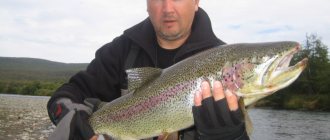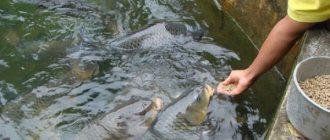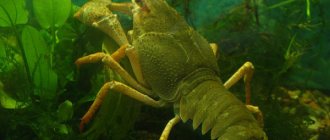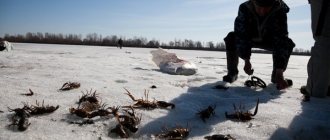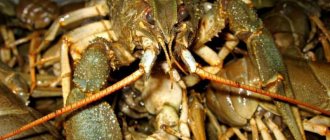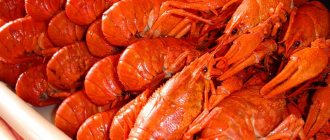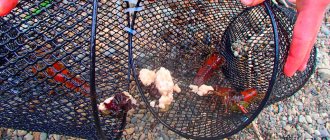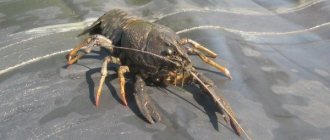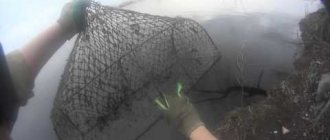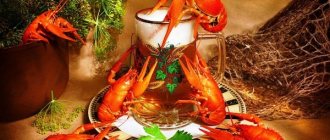External structure of crayfish
The body of the arthropod is covered with greenish-brown chitin, which protects the soft parts of the animal. The body consists of a massive cephalothorax and belly, which is narrow in males and wide in females. The head of the crayfish is cone-shaped, elongated, and ends with a sharp awl. It has movable eyes on both sides. A pair of short antennae act as organs of touch.
The olfactory organs are two long whiskers. The mouth opening is located at the bottom of the head, and at the top it is surrounded by the lip and jaws, which are necessary for digesting food. Crayfish have eight pairs of limbs. The front three are short jaws that help the arthropod feed. The rest are used for movement, three pairs of them with claws, which are the most important weapon. Thanks to them, the cancer defends itself or, conversely, attacks the victim.
Fishing methods and gear
Due to the expansion of net fishing, other methods of catching crayfish remain in the background or are completely forgotten. And yet, crayfish can be caught in different ways, which are not so easy, but are excitingly interesting for amateurs.
Hand catching
Catching crayfish with your hands is the most primitive and, apparently, the most ancient method. The catcher moves carefully in the water and looks under stones, tree trunks, and lifts the branches under which the crayfish hide during the daytime. Having noticed a crayfish, he tries to quickly grab it until it hides in a shelter or runs away.
Naturally, this fishing method is not suitable for those who are afraid of claws. The biggest catch happens in the dark, when crayfish emerging from their shelters can be caught by illuminating the bottom of the reservoir with a flashlight. In the old days, a fire was lit on the shore to attract crayfish. In this simple way, near the shore on a rocky bottom, where there are many crayfish, you can catch hundreds of them.
You can grab a crayfish with your hands only if the water depth is no more than 1.5 m. To catch crayfish in deeper waters, and in reservoirs with light water at a depth of even several meters, so-called crayfish mites were used in Finland. These wooden pincers are used to easily catch and lift crayfish from the water. Ticks can be from one to several meters long. To prevent the pincers from damaging the crayfish, they can be made hollow.
A simpler device is a long stick, at the end of which a split is made, and it is expanded with the help of a small stone or a wooden stick. It is impossible to pull a crayfish out of the water with such a stick; it is only pressed to the bottom and then lifted by hand. Fishing with ticks requires great skill, since crayfish, as soon as they sense danger, run away very quickly.
Due to their own slowness, the Finns did not widely use pincers as a fishing tool, and they did not become widespread. The unpopularity of this fishing method... apparently, it is also connected with the fact that in the dark waters of Finnish reservoirs it is difficult to notice the crayfish, and if the reservoir is a little deeper than a very shallow one, then it is completely impossible to see it.
This method of catching crayfish also includes underwater fishing. It requires special glasses and a breathing tube. Crayfish can be pulled out of holes with gloved hands or collected from the bottom at night. When diving at night, you need to have a flashlight, or your partner should illuminate the bottom from the shore or boat. Although a diver fishes close to the shore, various dangers always await him. Therefore, it is recommended that a partner be on duty on the shore and monitor the progress of fishing.
What do crayfish eat?
Both soft and hard plants are eaten. A favorite delicacy is the rhizome and stem of reeds, sedges, and reeds. During the day they eat food, the weight of which is equal to 2.5% of the total weight of the arthropod. Crayfish also happily consume animal food:
- water worms;
- insect larvae;
- small snails;
- tadpoles;
- small fish.
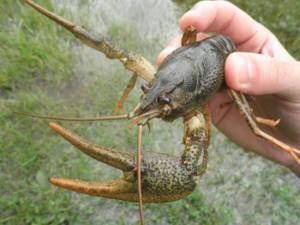
The nutrition of arthropods depends on age. The larvae prefer mainly animal food, which accounts for about 80% of the diet. The young, which reach a length of 2 mm, love chironomids and daphnia. When they reach two years of age, daphnia leave the diet. Crayfish, 2 cm long, begin to consume the larvae. In the future, as they grow, the consumption of amphipods increases. They do not swallow their prey, but bite it off in small pieces and slowly send it into the oral cavity.
How to boil crayfish in water
Boil the water. Add salt, a bunch of dill and other ingredients to your taste. Wait a few minutes and carefully plunge the crayfish into the boiling water. Try to hold them by the backs so as not to injure your hands, and lower them head down. If you are cooking for the first time, use a towel or oven mitts for safety.
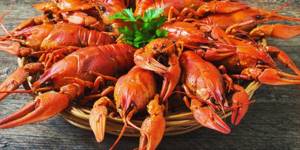
Boiled crayfish. Photo: OksanaYasiuchenia / Depositphotos
Cook small crayfish for 8-10 minutes, medium ones for about 15 minutes, and large ones for about 20 minutes. Afterwards, be sure to leave it to steep under the lid for 15 minutes.
Habitat
For comfortable living, crayfish require certain conditions:
- fresh water body;
- the oxygen concentration must be at least 5 mg per liter of water;
- pH 6.5 and higher;
- a sufficient amount of lime in habitats (otherwise the growth of crayfish is significantly reduced);
- hard rocky bottom with low silt content.
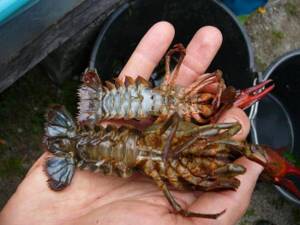
Where do crayfish live? River brethren prefer to live on the boundaries of hard and soft bottoms, in coastal holes or slopes of coastlines at a depth of one and a half to three meters. The best places for permanent housing are captured by large and strong males. Females and weak males live in less adapted conditions. Young animals are found in shallow water near the shore, under snags and stones. Crayfish are hermits and each of them has a shelter in which it hides from its relatives.
Aquarist's Guide
It can live for a long time in a cold water aquarium, but requires good care. For crayfish, you need a fairly spacious aquarium with cleanly washed pebbles and shelters made of stones. For normal growth and development, each crayfish more than 5 cm long should have at least 20 liters of water. The opinion that all ornamental crayfish come from the tropics is erroneous. Many of them live only in the subtropics, prefer coolness and are accustomed to seasonal climate changes.
Therefore, when catching wild animals for their subsequent keeping and breeding, you should think about the fact that animals should not be kept at the same temperature all year round. But domesticated animals, which have been bred in aquariums for many generations, over time lose their connection to natural rhythms and reproduce without problems even at constantly elevated temperatures.
Optimal conditions for keeping crayfish: water hardness 8-12°, temperature 23-25°C. Of course, as the temperature rises, the metabolism of crustaceans increases, and the interval between molts also shortens. Unfortunately, this shortens their life. With some exceptions, crayfish come from cold, oxygen-rich waters. Keeping them at room temperature with a decrease in temperature at night will not have any negative effect on them.
The color of crayfish is mainly due to carotenoids, mainly astaxanthin. Combining with proteins, it forms pigments of bluish and brownish colors. At high temperatures, these compounds are destroyed, and astaxanthin is released in free form, showing its primary red color. Therefore, boiled crayfish, like shrimp, turn red.
For the vast majority of crustaceans, it is recommended to maintain a pH value of 6.5 to 7.5 . As a rule, they do not live in acidic water. Crayfish also cannot tolerate increased acidity, because acidic water has little calcium, which is necessary for building the shell. The fact that these invertebrates have to take hardening substances from the water to build their shell speaks for itself. In principle, this process also occurs in soft water, but it is best in water of medium hardness (carbonate hardness from 5 to 10°dKH).
In aquariums with dwarf crayfish, aquatic plants also play an important role. If only floating plants, moss and epiphytic plants such as Java fern are planted, the bottom substrate plays a secondary role. But if rooted plants are planted in the aquarium, then it is best to purchase thoroughly washed fine quartz gravel as soil. Pebbles with a plastic shell can cause problems. From time to time, crayfish and shrimp die in a new aquarium with colored pebbles. Possible causes include softeners or other impurities. Aeration is necessary in the aquarium . It is recommended to purify and filter the water in the aquarium.
Crustaceans in a freshwater aquarium are very sensitive to the content of copper, ammonia and its derivatives (nitrites and nitrates). The presence of copper or ammonia, as well as the achievement of certain concentrations of nitrites and nitrates, leads to massive death of crayfish. Certain concentrations of copper or nitrites in the aquarium, which fish can easily tolerate, can be fatal for crayfish. For crustaceans, in general, the presence of these substances in the aquarium water should be reduced to zero.
If the accumulation of ammonia in the water of an aquarium means the quick and certain death of crustaceans, then nitrites gradually but irreversibly disrupt the process of saturating the blood of invertebrates with oxygen. Hemocyanin is responsible for the transport of oxygen molecules in the body of invertebrates (similar to hemoglobin in vertebrates). When hemocyanin reacts with nitrites, the gas exchange process is disrupted, the crustacean body does not receive enough oxygen, as a result of which they die from oxygen starvation. Nitrates, formed from nitrites, are the least toxic to crustacean living creatures. Special tests will help control the content of ammonia, nitrites and nitrates.
is an even stronger poison for crustaceans And if some diseases of aquarium fish can be treated with copper, then for shrimp and crayfish it is a win-win ticket to another world. Copper also enters the aquarium along with water from a copper-containing tap. With copper poisoning, the functioning of internal organs is disrupted, metabolic products accumulate, which leads to inevitable death. The copper content in the aquarium can be determined by appropriate tests.
Nitrites are a product of biological processing of organic and nitrogen-containing substances such as feed residues and waste products of fish and invertebrates. In an already “mature” aquarium, numerous bacteria quickly convert nitrites into much safer nitrates, but in a new aquarium the situation is different. There are still few nitrifying bacteria here, and therefore an avalanche-like accumulation of nitrites occurs - the so-called nitrite peak. Nitrites suppress gas exchange processes in the gills, or more precisely, in the thin gill filaments. Through the gills, nitrites enter the blood of fish and block hemoglobin, which is responsible for the transfer of oxygen. Gas exchange is disrupted, and death from suffocation occurs.
Each cancer is an “individualist” : it lives separately from its fellows; if it digs a hole, it is only for itself; if it finds shelter under a stone or snag, it captures it and vigilantly guards it, with its claws out. Crustaceans are characterized by complex forms of behavior and a highly developed ability to adapt to the environment.
Fluctuations in water and a sound signal cause a distinct orienting reaction in crayfish: the animal stops, raises its rostrum, orients its antennae and antennules, opens its claws slightly, puts them in a boxer's position, and quickly turns to the source of irritation. The final decision is made based on the analysis of the stimulus. If there is a food source - attack, a rival - expulsion, danger - avoidance. A floating shadow especially affects behavior. Crayfish usually see it well and quickly take a defensive pose, and then swim away 5-10 m, into the shadow zone or light zone.
When keeping freshwater crayfish, it is especially important to create a secluded area for them using decorative objects, since some specimens react aggressively to constant encounters with other inhabitants of the aquarium. The aquarium must have shelters in which males usually hide. When several individuals are kept together, the lack of a sufficient number of shelters will lead to conflicts. For adult crayfish, ceramic tubes, coconut shells, flower pots, etc. can serve as shelters. Various objects lying on the bottom can be used as shelters. If this is not taken care of, the crayfish themselves dig holes under stones, snags, and even under the roots of large plants. Crayfish dig their burrows using their legs and tail, supported by their front claws.
It is also good to place driftwood in the aquarium. Young crayfish hide in thickets of small-leaved aquarium plants. Females, as long as they are not burdened with caring for their offspring, almost always remain visible, exploring all corners of the aquarium in search of food. Freshwater crayfish spend most of the day, about 12-14 hours in summer, in burrows or other shelters. Cancer is also a very funny animal. Despite his apparent clumsiness, he walks easily on his eight legs until he encounters any obstacle.
For crayfish it is necessary to organize access to the surface of the water, i.e. make sure that they can climb up some objects (tall plants, hoses of aquarium equipment, pieces of tuff or driftwood, etc.) to the surface - crayfish can sometimes stay at the surface for quite a long time. All crayfish have a tendency to leave the aquarium. Therefore, the aquarium must be closed with a lid and the openings for wires and hoses must be so narrow that no animal can get out through them.
The crayfish usually does not try to get out of the aquarium; it lives at the bottom. But if the water becomes rotten or there is not enough oxygen in it, then the cancer begins to actively seek salvation on land and can escape from the aquarium. When the aquarium is overpopulated with crayfish or there is not enough shelter, they also make attempts to get out, trying to get away from the aggression of their larger relatives.
During the day, crayfish usually hide in their shelters, and in the evening they go in search of food. They feed on a wide variety of food, so feeding them in an aquarium is not difficult. In periods preceding intense energy expenditure (reproduction, molting), the amount of food consumed increases, especially due to an increase in the specific gravity of the animal component.
The daily ration to body weight is greater in juveniles than in adults, and greater in males than in females. The feeding frequency in nature for males is once every 2 days, for females - once every 3 days. Freshwater crayfish eat both animal and plant foods, with plants making up a significant portion of their highly varied diet. The share of plants can reach up to 90 percent.
Mollusks, worms, insects and their larvae, tadpoles are the main animal food; among plants, crayfish eat pondweed, elodea, nettle, water lily, horsetail, many algae, and even carrots under artificial conditions. In an aquarium, they can be fed with bloodworms, small pieces of fish or meat (the main thing is not too fatty), they also eat plant foods, and sometimes they can trim thin plant trunks with their claws. Shrimp and crayfish very readily get used to special food. In it they find all the nutrients they need in concentrated form. They eat whatever the hobbyist feeds his fish.
You can feed the fry with ready-made food for fish fry, chopped tubifex, and brine shrimp. Young crayfish in an aquarium are very useful. Every day, or rather nightly, he carefully examines the entire aquarium and collects all kinds of garbage. Decapod crustaceans primarily graze on the substrate and eat detritus, that is, a mixture of organic decay products of living matter along with the bacteria, fungi and microorganisms involved in this process.
A good natural substitute can be fallen leaves . You can put dry tree leaves in the aquarium. Under no circumstances should fresh leaves be placed in the aquarium, as they release toxins. The best ones are oak, beech or alder leaves.
Such leaves are a source of valuable food for crustaceans, which cleanses their digestive system and helps get rid of parasites. In addition, they release a certain amount of tannins and humic acids into the water, the presence of which has a good effect on shrimp. Instead of leaves from domestic trees, you can also use Indian almond leaves. They not only improve the quality of water, but also to a certain extent have an antiseptic effect and protect the inhabitants of the aquarium from diseases. Since the leaves are systematically eaten by crayfish, after some time they need to be replaced with new ones. They do not attack anyone and eat plants and dead animals, performing the role of orderlies of the reservoir.
It is better not to plant live plants in an aquarium with crayfish to avoid their damage. Aquarists have repeatedly encountered mass deaths of crayfish after planting new, purchased aquarium plants in an aquarium, especially in pet stores. Not everyone knows that suppliers, in order to avoid transmitting any parasites or harmful insects with plants, treat them before shipping with insecticides that are dangerous for aquarium shrimp and crayfish.
They will not be able to catch moving fish, such as barbs, but it will not be difficult for them to trim the fins of even large angelfish. The greatest danger is faced by small fish that sleep at night, sinking to the bottom. Therefore, it is better not to keep fish that occupy the lower, bottom layers of water in the aquarium together with crayfish. If you want to combine fish and crayfish in one aquarium, you need to match crayfish to fish, and not vice versa, fish to crayfish.
of the Procambarus family , living in the USA, Mexico and some Caribbean countries, have become widespread The most common species of this group, Procambarus clarkii (Red Swamp Crayfish).
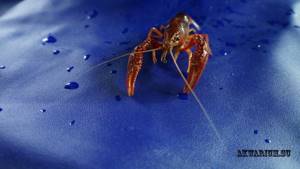
Large species of Procambarus crayfish, unfortunately, have one common bad habit: they readily eat plants. There are, of course, individual characteristics. For example, some crayfish do not touch plants with hard leaves for a long time, but sooner or later they will get to them.
In large home aquariums, livability, even of the American crayfish Cambarus , with a rather calm temperament, is extremely rare. In recent years, North American crayfish from the families Orconectes and Cambarus . Partly we are talking about extremely hardy and colorful species.
However, these crayfish do not coexist peacefully with bottom-dwelling fish, since this area has always been their living space. All currently common Cherax belong to the group of medium- and large-sized crayfish. This does not always mean that they require huge aquariums. However, they happily live in a large space with plenty of hiding places. The so-called blue or Cuban crayfish are of greater interest to aquarists; they are precisely suited to the temperature conditions of home aquariums, where they can reproduce freely.
It is better to transport crayfish one at a time in a container using a dry method.
The procedure for adapting to aquarium water is not difficult. A new animal just needs to be released into the water, making sure first that it is fresh and that its temperature is in the range of 20-30 degrees Celsius. (Visited 9 684 times, 8 visits today)
Hunting for arthropods
Where is the best place to catch crayfish? In clean rivers with warm water, enriched with oxygen. In some reservoirs you can catch crayfish at a shallow depth (50 cm), and in others - from two to three meters. In rivers with a clay bottom, they dig holes about a meter long. Arthropods also find many shelters in places with a rocky bottom. In the first month of summer, crayfish with a strong shell can be found if the spring is warm. If the summer is cool or cold, hunting should be postponed until the fall. Where is it useless to catch crayfish? In shallow water, in reservoirs with a sandy or muddy bottom covered with thick algae.
Myth four. You need to buy the biggest crayfish
It is best to have your own trusted place to buy or a point on the market. You should not take ones that are too small (less than 10 cm) - the efficiency when cleaning is too low. And most often they are the result of poaching. But you shouldn’t buy crayfish that are too big either - they may be too empty. The main thing is that the cancer must be alive and mobile. A good seller will be sure to throw each individual on its back, demonstrating that it is desperately moving, trying to roll over.

Best time to fish
In some regions of the country, crayfish fishing is limited or completely prohibited. They cannot be hunted during the period of bearing future offspring. In some areas, the permissible size of crayfish is established, upon reaching which they can be caught.
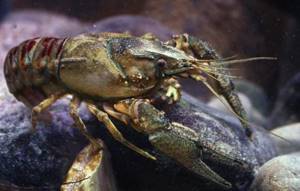
A complete ban on these actions exists in the Moscow region and directly in Moscow itself. Therefore, you don’t have to be interested in the question of where crayfish are found in the Moscow region. During the fishing period, no more than three traps or crayfish traps with a diameter of 80 cm and a cell pitch of about 22 mm can be used per person. Hunting by hand by diving or wading is prohibited. For illegal fishing in each region there is a fine, the amount of which varies in regions.
Myth three. Cleaning crayfish is difficult
It is difficult to describe in words the process of properly cleaning cancer. The main mistake is to wear a new beautiful T-shirt or shirt. Even a master of sports in crayfish is not immune to splashes. Crayfish are eaten with your hands and only your hands. And skill comes with experience.
Traditionally, the neck (tail) of cancer is cleaned and the esophagus, a thin black thread, is removed. Gnawing the claws with their teeth, they eat the meat and suck the juice from the paws. They remove the shell and suck out the juice, eat the fat and a little meat in the head part. It’s not very appetizing to describe it, you just need to clean the crayfish and not leave anything unattended!
Places where you can find arthropods
Mastering the knowledge of where crayfish are found is a prerequisite for a rich catch. There is an opinion that they live in rivers with standing water, as well as in swamps. However, these arthropods prefer clean flowing water bodies with gentle currents.

In each of them there are areas that these animals have chosen for permanent residence:
- Coastline with stones. This is the most attractive place for crayfish to be found, as they can live near the surface of the earth under cobblestones. They build burrows at the bottom of the reservoir and hide in them during the molting period.
- Coast with cliffs. In cases where the depth in the river varies, and under the coastline can reach two meters, crayfish settle in these places. A prerequisite is the presence of peat or silt on the bottom surface of the reservoir.
- Backwaters with snags are places where crayfish are found in large numbers. It is there that you can find quite large specimens.
- Sandy bottom of the reservoir. In these places, hunting crayfish is very easy. There is little algae, the bottom is transparent and clearly visible. A successful hunt awaits everyone in these bodies of water.
- Shell rock. The bottom dotted with them and the presence of areas with reeds indicate the presence of crayfish in these places.
- Holes and holes in the ground. In places with steep banks, small holes with a diameter of about five centimeters can be observed. Crayfish live in them.
- Banks in water. The presence of beer bottles and other containers in the water are places where crayfish are found, they hide in them. When fishing, you should check each of them.
How to prepare crayfish
To begin, place the crayfish in a basin or bucket. Fill with water at room temperature and leave for an hour.
Then rinse under running water. If crayfish are covered in sand, mud or other debris, use a brush to scrub everything off. Otherwise, the finished dish will not have a very pleasant taste.
Washed crayfish can be additionally soaked in milk. This way their meat will be more tender and juicy. To do this, pour the crayfish with full-fat milk so that they are completely covered and leave for half an hour. Afterwards, rinse thoroughly under running water.
Conditions for quality catch
- Well ventilated and illuminated pond. In a murky and dark environment, crayfish will move very quickly and be difficult to catch. When hunting in such conditions, special traps are set at noon and checked in the morning.
- A certain time of day. How to catch crayfish in the summer? During the daytime, arthropods hide and are not active. During this period, you can find those individuals that are not very well hidden and catch them with your hands. After sunset, crayfish begin to peak in activity. This time is considered ideal for setting traps. Some prefer to hunt them at night, using flashlights to search for them. When hunting in the warm season, you will find a rich catch. In late autumn and winter, crayfish live in their burrows and do not leave them until the onset of hot days.
Features of cancer nutrition
Crayfish are a crepuscular inhabitant of water bodies. It begins to feed most actively at dawn and after sunset. In cloudy weather, he can hunt for food not only at night. Crayfish do not tend to travel long distances from their home, even in search of food. The distance traveled by these animals from their burrows is, in most cases, 1-3 meters. Crayfish prefer mainly plant foods, which make up 90% of their diet, but sometimes they do not neglect animal foods. Plant foods include: various algae and certain types of plants (in particular, horsetail, pondweed, elodea, as well as water lilies and nettles). In winter, crayfish can also feed on fallen leaves. Animal food includes: insects and their larvae, worms, tadpoles and various mollusks. Crayfish do not disdain carrion, which is a constant component of their diet. Often, crayfish eat the corpses of animals and birds completely.
There are several methods for catching crayfish. Most people prefer to catch these bottom dwellers with their hands. Some people use special devices for this: crayfish traps, crayfish traps of various designs.
Hunting for arthropods
How to catch crayfish in the summer or at other times? First you need to find the body of water in which they live.
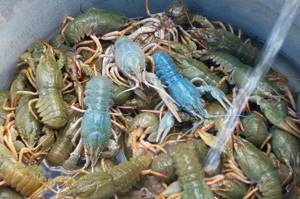
- Most beaches have places where reeds grow; as a rule, people do not swim there and do not scare the crayfish. Slowly swim along the reeds and carefully inspect the bottom, as they hide well in the reeds.
- Catching crayfish in quiet places with tree roots and snags is a real pleasure, the main thing is to know the bottom. To hunt them, one must resolutely avoid making any sudden movements. Large individuals usually live in such places. They are quite slow and do not present any difficulties for experienced catchers.
- In rivers with a rocky bottom, there are many natural burrows for crayfish, in which they often hide from danger. It is better to grab them by the whiskers than by the claws. Do not put your hands into the holes, there is a possibility of injuring them. There are known cases when large stones crushed the upper limbs of catchers.
- In reservoirs where the bottom is strewn with remnants of reeds, as well as river mollusks, crayfish are frequent guests. You must swim carefully, examining the bottom. Be careful as you can easily injure yourself on the clam shells.
- The best place for both beginners and professionals is the sandy river bottom.
- You need to be very careful when catching crayfish in a hole. If you find a place where the depth is two to three meters near the shore, then you can see several passages under the water. Live crayfish in such burrows are very rare; these burrows belong to musk rats. Crayfish houses are small, up to five centimeters high and eight centimeters wide, depending on the size of the arthropod.
- My favorite place is broken bottles with the whole bottom left in them. Most jars and bottles contain crayfish. There are quite a lot of such containers in almost any body of water.
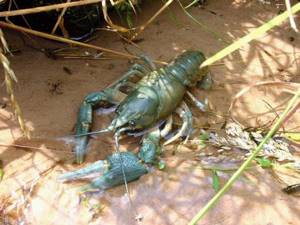
If you are not interested in hunting for crayfish on your own, you can buy one. When choosing, you should pay attention to the tail. In a living cancer it is pressed tightly to the body.
Bait selection
To lure crayfish into a trap, you need to offer them good bait. The most popular and bringing a good catch are:
- bread with garlic;
- fresh fish;
- rotten meat;
- frogs.
Bread with garlic is a fairly simple and catchy bait option. The ideal option would be bread and garlic passed through a meat grinder, well mixed and formed into balls, which are recommended to be placed in small gauze bags. Dill is also added to the mixture if desired.
fresh fish for bait you should pay attention to bream and roach. This type of fish is a delicious delicacy for arthropods. The fish should be cut and turned inside out so that the meat is on the outside. Very often, crayfish fishermen offer rotten meat to their prey. In the warm season, beef liver or chicken gizzard with a well-defined rancid aroma are perfect. A hungry arthropod will quickly approach a pronounced smell.
frog bait is perfect It's quite simple to do. The frog must be cut into 4 pieces, after removing the skin from it. Slices of dried frog are no less catchy.
Chemical composition of cancer
Crayfish are caught for tasty, healthy and tender meat. The lion's share in it comes from proteins - 82%, fats - 12%, and carbohydrates - 6%. There are only 76 kcal in 100 g of edible part.
Meat contains many different vitamins: almost all representatives of group B, fat-soluble vitamins A and E, nicotinic and ascorbic acid. The mineral composition is also diverse - potassium, phosphorus, sodium, sulfur, calcium, magnesium, iodine and iron.
The benefits of crayfish meat are explained by the fact that the vitamins and minerals in it are balanced. Low calorie content and a lot of easily digestible protein make it indispensable for dietary nutrition. Experts also advise its use by people with cardiovascular diseases and liver diseases, with disorders of the nervous system and blood circulation. However, crayfish are strong allergens; if you are intolerant to the product, you should immediately discard it.
Origin of the species and description
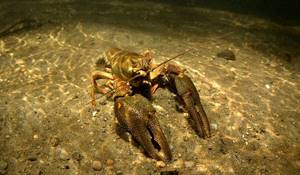
Photo: Broad-toed crayfish
The broad-toed crayfish is a representative of the order of decapod crayfish from the crustacean family under the Latin name Astacidea. Ten-legged crustaceans can be called the most extensive order of the class of higher crustaceans, which contains 15 thousand modern species and 3 thousand fossils. As already noted, crayfish inhabited our planet 130 million years ago (in the Jurassic period), which makes it even more amazing and interesting to study. It would be more correct to call it freshwater, because... It is in such water that he lives. It was nicknamed broad-fingered because of its wide, massive claws, thereby denoting its difference from its narrow-fingered river brother.
Video: Broad-toed crayfish
In addition to the differences in the width of the claw, the broad-fingered crayfish has a notch with sharp tubercles on the inside of the motionless finger; the narrow-fingered crayfish does not have it. The female is smaller than the male crayfish. Its claws are also noticeably smaller, but it has a wider abdomen. In addition, the two pairs of abdominal legs of the female are in an underdeveloped state, in contrast to the same legs of the males.
In general, the broad-toed crayfish has a rather large, massive, jointed body, which is covered with a strong shell of chitin. It is not difficult to guess from the name of the order that the crayfish has five pairs of walking legs. The first two pairs are represented by claws. If we talk about the dimensions of this crustacean, then it can be called the largest of the freshwater crayfish living in our country. The average size of females is about 12 cm, and males - from 15 to 16 cm. It is extremely rare, but there are males up to 25 cm in length and weighing about two hundred grams. Crayfish of very advanced age, about twenty years old, reach this size and weight, which is why such specimens are rare.
Appearance and features
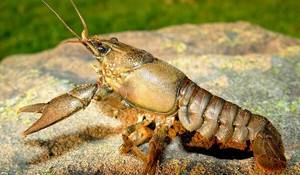
Photo: Broad-toed crayfish in nature
If everything is clear about the size of the cancer, then its color is different, it all depends on the places of permanent cancer dislocation.
He can be:
- dark olive;
- greenish-brown;
- blue-brown.
Crayfish have an excellent talent for camouflage, so they correctly blend in with the color of the bottom of the reservoir where they have permanent residence. Looking at the crayfish, it is immediately noticeable that its body consists of two main parts: the cephalothorax, consisting of segments of the head and sternum (the place where they are fused can be seen on the dorsal part) and the segmented abdomen, which ends with a wide tail. The cephalothorax, like armor, is protected by a strong chitinous shell.
The shell plays the role of a crustacean skeleton, under which all the internal organs are hidden, and it also serves as an attachment for the muscles of the crustacean. Immediately striking are the long antennae, which are very sensitive and perform olfactory and tactile functions. At their base are the organs of the crustacean balance. The second pair of whiskers is much shorter than the first and is used only for touch. The crayfish head begins with a sharp projection called the rostrum. On both sides there are convex black beady eyes located in a recess. It seems that the eyes of the crayfish grow on thin stalks that are mobile, so the mustachioed one has a decent view, nothing can be hidden from him.
Interesting fact: Crayfish eyes are of the compound type, i.e. consist of several thousand small eyes (about 3000 pieces).
The mouth of a cancer is a rather complex structure, which consists of various limbs:
- one pair of mandibles, which are the upper jaws;
- two pairs of maxillae acting as lower jaws;
- three pairs of maxillipeds, otherwise known as maxillomandibles.
The very anterior legs of the crayfish are called claws; they act as a grasping, holding and defensive apparatus. To move, a crayfish needs its long walking legs, four pairs. Arthropods also have smaller limbs, called abdominal ones. They are necessary for the respiratory system. Their crayfish use them to bring oxygenated water to their gills. Females are endowed with another pair of two-branched limbs necessary for holding eggs
The crayfish tail is immediately noticeable, because it is quite long and large. Its last, flatter segment is called the telson; it is very helpful in swimming, which is performed backwards. It’s not for nothing that they say that crayfish actually back away. Raking its tail under itself with vertical movements, the crayfish retreats with lightning speed from the place where it sensed a threat.
Storage and transportation of crayfish

Most often, caught crayfish must be stored for some time before consumption. They are usually stored in cages. It must be borne in mind that in order to localize possible infectious diseases, crayfish in cages should be kept in the reservoirs from which they were caught. Low boxes made from boards with holes drilled in the walls, or boxes with slots, have proven themselves best as cages. Crayfish are well preserved in cages made of wooden planks or metal mesh.
Crayfish should be kept in cages for as little time as possible, since they eat each other, especially helpless individuals. When storing crayfish for more than 1-2 days in cages, they need to be fed so that they are better preserved and less likely to attack one another. The usual food is fresh fish. Crayfish can also be fed with nettles, alder leaves, potatoes, pea stems and other plant foods.
We suggest you familiarize yourself with: Boats ndnd rating - lodkaVmore
Crayfish are usually transported without water, in spacious boxes. Wicker baskets are especially practical, as are wooden, cardboard and plastic boxes, as long as they have enough air holes.
Crayfish are placed in boxes about 15 cm high in only one row. It is recommended to lay a layer of damp moss, grass, nettles, aquatic plants, etc. on the bottom of the boxes, as well as on top of the crayfish. In higher boxes, intermediate shelves are made from slats so that the layers of crayfish do not fit tightly to each other. They can be transported safely and without intermediate partitions, layered with layers of damp moss.
When transporting crayfish in the summer heat, it is necessary to ensure that the temperature in the boxes does not rise too high. To do this, you need to cover the boxes from direct sunlight, place bags of ice around the boxes, etc. In hot weather, it is better to transport crayfish at night. To maintain the desired temperature inside, the outside of the boxes can be lined with any dry material.
According to the recommendation of the Germans, crayfish should be allowed to dry for half a day after being caught before being placed in boxes. There is also an opinion that crayfish tolerate transportation better if they have not received food for some time before.
The main measures for caring for crayfish in natural reservoirs are: - elimination of crayfish diseases, especially crayfish plague; - compliance with recommendations for catching crayfish; - replanting crayfish; - reducing the number of weed species in the reservoir; - improving the habitat of crayfish.
The duty of every crayfish catcher is to help localize the epidemic, prevent it from spreading widely, and follow the recommendations developed for these cases.
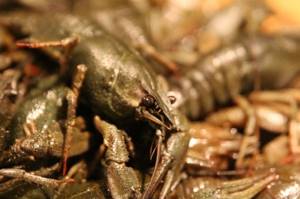
Intensive fishing for crayfish is one of the effective methods of increasing the number of crayfish in a reservoir. Since crayfish reach sexual maturity already at a length of 7-8 cm, and the minimum size allowed for catching crayfish is 10 cm, mass catching of crayfish will not harm their population in the reservoir. On the contrary, when large and slow-growing individuals that occupy the best habitats are removed from the reservoir, the reproduction of crayfish accelerates. Females with eggs and crustaceans should be immediately released into the water.
Individuals 8–9 cm long that have reached sexual maturity are suitable for dispersal. Resettlement should be carried out in August at the latest, so that the crayfish have time to acclimatize to the new habitat before mating begins and the onset of winter.


